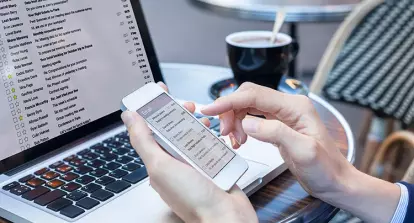Back in the days when email marketing was just generating hype, a common tactic was to send a generic email to thousands of people. Those could be a plain body of texts, an e-poster, or a body of text with attachments like PDFs. However, marketers started using templates as technology advanced, mainly to send personalized emails, reduce time, and make email campaigns more effective.
Simply put: an email template design is a pre-set email with blank spaces to enter personalized details of the contacts. A smart marketer does not spend hours to copy and paste emails, instead, they use email marketing platforms to send thousands of customized emails by using templates. Email marketing platforms offer a plethora of email templates that you can customize according to your goals.
Plain Text vs Visual Email Template
Generally, there are two types of email templates. Templates those have nothing but texts and the ones that are designed to strike visually. Depending on your goals, target population, and business type, you need to decide which way you are going. If you are sending emails to C-suite folks for B2B meeting purposes, you can use plain text templates. On the other hand, if the goal of your mass email campaign is to drive someone to your website or sign up for a cause or download an e-book, using a visually rich email template is not a bad idea.
You can have a basic idea of how to craft an effective plain text email in our
In this blog, we will focus on the steps to design a visually appealing email template!
Visual Email Template: Sections
When it comes to designing email templates, jumping right into designing is not an uncommon norm. However, having a structure in mind helps a lot because then you will be able to customize your template based on your end-goals.
A typical HTML encoded email template has the following sections:
1. Write a Killer Subject Line & Preview Text
The first impression is the last one! The subject line and preview text are what gets your email opened. It is your whole email is summarized in one line. This is the gateway where the reader will decide if he/she will click and open the email. There are quite a few tricks to write a persuasive subject line which we go over in this sales email blog.
While the subject line works as the summary, preview text gives the reader an extended idea of what they’re in for. Preview text is what you can see right below or after the subject line. Using the right preview text can bolster the impact of your subject line and persuade the user more to open the email.
2. Place a Header
Eye-catching headers immediately grab your readers’ attention and make them move down to the body. Here is how you can design your header:
- Logo only: On a plain colored background, you could opt to only put your logo! Simple as that. But, make sure the logo is visible and contrasted to the background color.
- Company name in brand color: Another easy template header is to write your company name on a block of your brand color.
Company name/logo on a photo: A visually striking and relevant photo can grab attention easily. Put your logo or company name on top of a picture. But make sure that the logo/name is visible enough and the picture is complementary to your brand color. Using this tip, you can customize headers just by changing the background picture while keeping all the templates consistent.
3. Craft the Template Body
This portion is like an email body. Once you grab the readers’ attention with a cool header, you need to convey your message and information in this section. You need to consider three elements of an email template body: layout, background color, copy, and images.
Setting Up Layout
A layout is how you display the entire body, including content such as images or texts, and how you manage the white spaces (blank areas in the template). There are quite a few ways to set up your email layout. Here are the most common types:
- Inverted Pyramid: It starts at the top of the body. As you move down, content takes fewer spaces, leaving more whitespace.

- Single Column: The entire email body will be put in one column.

- Double Column: A quite common email body that contains two columns. It is sometimes more interesting because you have a chance to use an image banner in one column and text details in another.

- Triple Column: Not quite common as a single or double column. In special cases, for instance, when you want to provide product details, the triple column email template becomes handy. However, since a major portion of users view emails on their mobile phones, it is better not to use a triple column if a single or double column layout can do the job.

- Mixed: Depending on the product and information you want to convey; you can use a mixed template. This technique includes some of the methods mentioned above. You might want to describe your company in one column and below that, provide the top two deals in a double-column block.

Once you have decided on the layout, you can move to the next elements.
Picking a Background Colour
If you have ever attempted to listen to a piece of rock music without bass, you know the importance of background. Similarly, a complementing background augments an email template’s smoothness and increases reader experience. The golden rule is to contrast the content and the background. If the background is dark, content should be light-colored or vice versa. The goal is to make the readers read the email easily, not scratch their eyes.
Once you have chosen your background color, it is time to select images and write copy for the template. It is essential to remember that images and copy go side-by-side. As you proceed, you might have to make changes to both elements. Nothing is permanent, eh?
Selecting Resonating Images
Your email template needs to go easy on the readers. Images play a vital role and, depending on your goal and the image to text ratio, you can either to accompany large blocks of texts or use a really large image with a small block of text on it. Not really strictly black and white.
Image Foucses vs Text Focused Email Template Designs.
Usually, products or services that deploy emotional appeal adopt an image-focused template. On the other hand, email templates for retail items and offers focus on text blocks because of the information-rich layout. Whatever works for you.
Following these tips may help:
- Use brand-consistent images. If your company mostly uses dynamic, energetic images, it is best to keep it like that. Using a super lively image in a dark-themed email design will look a bit odd to readers.
- Use an image that not only describes a product, service, or business but also tells a story.
- Optimize the images for the web. The most common mistake is using a heavy image without reducing the pixel per inch, which results in longer loading time. If possible, try using images for the high-end displays.
- Don’t forget to include alt text for your images. Often images are blocked by the readers or for those who have difficulty in viewing images. Alt text will give them an idea of what is in that image.
4. Writing A Persuasive Copy
Your layout, background, and image will provide the user with a sense of what you want to tell them or provide them with an emotional push. But your copy is the talisman here. Writing persuasive copy is the final piece of the puzzle. If the copy can arouse interest, your prospects are likely to perform your desired action.
There are many tips to write a persuasive copy. However, these tips will be useful to craft a copy for email templates:
- Use web-friendly fonts and make sure that the colour of the copy contrasts the background.
- Personalize the message. Often it is not possible to get down to an individual level of personalization. In that case, craft a persona of your target market and write copies to engage them. Keep it casual and conversational based on the target segments.
- Refrain from using jargon and complicated, geeky terms.
- Keep the copy concise. Especially when you are doing an image-focused template, you might end up using only 5-10 words for each section.
- Keep it consistent with your brand identity, tone of the image, background, and header. Using humor is great when your target audience is Gen Z. But when you are reaching out to the top-notch corporates with a B2B service, you might want to keep it a bit more serious.
5. Enter Call-to-Action
Imagine you have crafted a killer email template and sent it to over 10 thousand hot prospects. 50% of them are so impressed with your email that they want to get your service. Unfortunately, they don’t find anything to do and after spending a few moments cluelessly, they close the email!
Ah! Here goes your day after realizing the mistake!
A great CTA answers the “What’s Next?” your readers ask. Give them an answer. The most commonly used CTAs are Buy Now, Order Here, Click Here, etc.
ALWAYS give a concise, clear, direct, easily findable call to action!
Showing the latest offer? Give them a button to add that to the cart. Want them to read a whitepaper? Give them a download link or a signup form. Want them to call you back? Write your phone number in a giant block.
Here are some tips to write effective CTAs:
- Start with an action: Call Us, Download Here, Sign Up Today, etc.
- Use persuasive lines: Get Your Discount Today, Plan Your Summer Trip, Check Out More Offers, Enter Your Discount Code Here
- Give them a sense of urgency in a few words before you give them a CTA: Don’t Miss Out Your Free Game - Join Now, Want This Item by Friday? - Order Now
6. Place a Footer
Although it is not as important as the above elements, the footer can be helpful to close the email template. A footer can be used in multiple ways. The most common use is writing content in a block at the bottom of the email template. Here is what you can do:
- Writing applicable conditions. Usually in smaller fonts, so you can pack more information in there.
- Embedding social media icons in case the readers get curious and want to check your social media sites.
- Providing them with an unsubscribe link. This is important because it helps you to comply with anti-spam laws. You don’t want to bug a prospect who no longer wants to hear from you.
When you make the footer, it is best to use the same color block and font used in the header. But you can do it differently so long as you keep the consistency.
There you go! By now, you should have a great email template. All you need to do right now is to find your contacts, set up the email template in the platform and hit the send button!
Just in case you need inspiration from existing email template designs, Really Good Emails gives you tons of them.
Don’t Have Time?
Creating email templates from scratch by manually designing graphics and coding the template with HTML/CSS might be cumbersome for many marketers. On top of that, it will be even harder to send emails manually.
Don’t spend hours doing all these things manually! SimplyCast’s Email Marketing tool brings you a wide range of pre-set email templates that you can customize based on your needs. You can add images, edit copy, select your layout and when your email template design is ready, you can easily send the personalized emails from within the application.
Easily design a campaign timeline through the drag-and-drop editor and automate the entire campaign. Create stunning, personalized emails with attention-grabbing visual elements, track your campaign success through different metrics, and generate a detailed report to create more effective future campaigns.
You have all the features you need!




